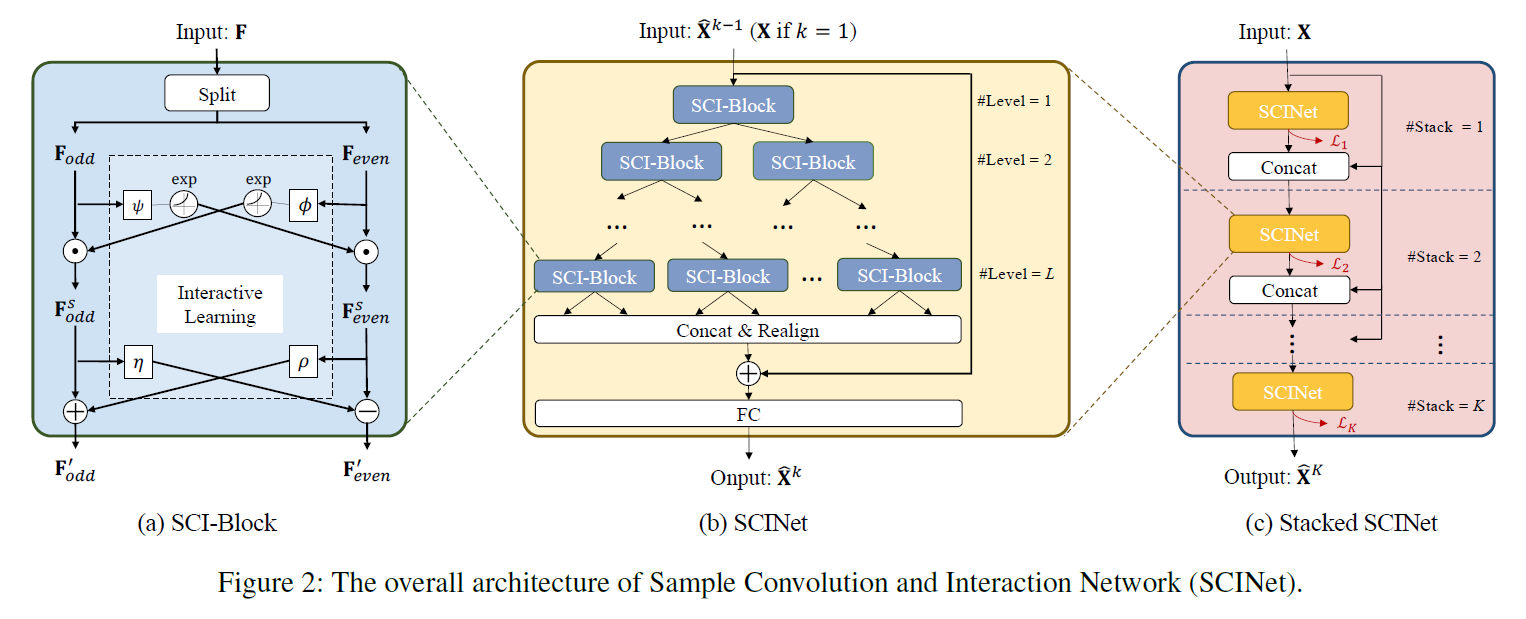Time Series is a Special Sequence : Forecasting with Sample Convolution and Interaction (2021)
Contents
- Abstract
- Introduction
- Related Work & Motivation
- Related Work
- Rethinking “Dilated Causal Convolution”
- SCINet : Sample Convolution & Interaction Networks
0. Abstract
3 components in TS
- 1) trend
- 2) seasonality
- 3) irregular components
propose SCINet
- conducts sample convolution & interaction for temporal modeling
- enables multi-resolution analysis
1. Introduction
TSF (Time Series Forecasting)
Traditional TSF
-
ARIMA, Holt-Winters
\(\rightarrow\) mainly applicable to “univariate” TSF
TSF using DNNs
- 1) RNNs
- 2) Transformer
- 3) TCN (Temporal Convolutional Networks)
- most effective & efficient
- combined with GNNs
\(\rightarrow\) ignore the fact that TS is a special “SEQUENCE data”
SCINet
contribution
- 1) propose a hierarchical TSF framework
- iteratively extract & exchange information, at “different temporal resolutions”
- 2) basic building block : SCI-Block
- down samples input data into 2 sub-sequence
- extract features of each sub-sequence ( using distinct filters )
2. Related Work & Motivation
Notation
- \(\mathbf{X}^{*}\): long time series
- \(T\) : look-back window
- goal :
- predict \(\hat{\mathbf{X}}_{t+1: t+\tau}=\left\{\mathrm{x}_{t+1}, \ldots, \mathrm{x}_{t+\tau}\right\}\)
- given \(\mathbf{X}_{t-T+1: t}=\left\{\mathbf{x}_{t-T+1}, \ldots, \mathbf{x}_{t}\right\}\)
- \(\tau\) : forecast horizon
-
\[\mathrm{x}_{t} \in \mathbb{R}^{d}\]
- \(d\) : # of variates
- omit subscripts! will use \(\mathbf{X}\) and \(\hat{\mathbf{X}}\)
Multi-step forecasting ( \(\tau >1\) )
- 1) DMS ( DIRECT multi-step ) estimation
- 2) IMS ( ITERATED multi-step ) estimation
(1) Related Work
RNN based
- use internal memory state
- generally belong to IMS
- suffer from error accumulation
- gradient vanishing/exploding
Transformer
- self attention mechanism
- problem : overhead of Transformer-based models!
Convolution based
- capture local correlation of TS
- SCINet is constructed based on TEMPORAL convolution
(2) Rethinking “Dilated Causal Convolution”
Temporal Convolutional Networks
-
stack of causal convolutions ( to prevent information leakage )
with exponentially enlarge dilation factors ( for large receptive field with few layers )
Causality should be kept!
- “future information leakage” problem exists, only when the output & input have temporal overlaps
- that is, “causal convolutions” should be applied only in “IMS-based forecasting”
propose a novel “downsample-convolve-interact architecture”, SCINet
3. SCINet : Sample Convolution & Interaction Networks
Key points
- “Hierarchical” framework
- capture “temporal dependencies” at multiple-temporal resolutions
- basic building block = “SCI-Block”
- 1) down sample input data into 2 parts
- 2) distinct filters for 2 parts ( extract both homo/heterogeneous information )
- 3) incorporate “interactive learning”
- SCINet = multiple SCI-Blocks into a “binary tree” structure
- concatenate all low-resolution components into new seqeunce

(1) SCI-Block
abstract
-
[ input ] feature \(\mathbf{F}\)
- [ output ] sub-features \(\mathbf{F}_{\text {odd }}^{\prime}\) and \(\mathbf{F}_{\text {even }}^{\prime}\)
- [ method ] by “Splitting” & “Interactive Learning”
Step 1) split
Step 2) different kernels
- extracted features would contain “homo” & “hetero”geneous information
- 2 different 1D CNN ( \(\phi\) , \(\psi\) )
Step 3) Interactive learning
- allow information interchange
- \(\begin{gathered} \mathbf{F}_{\text {odd }}^{s}=\mathbf{F}_{\text {odd }} \odot \exp \left(\phi\left(\mathbf{F}_{\text {even }}\right)\right), \quad \mathbf{F}_{\text {even }}^{s}=\mathbf{F}_{\text {even }} \odot \exp \left(\psi\left(\mathbf{F}_{\text {odd }}\right)\right) . \\ \mathbf{F}_{\text {odd }}^{\prime}=\mathbf{F}_{\text {odd }}^{s} \pm \rho\left(\mathbf{F}_{\text {even }}^{s}\right), \quad \mathbf{F}_{\text {even }}^{\prime}=\mathbf{F}_{\text {even }}^{s} \pm \eta\left(\mathbf{F}_{\text {odd }}^{s}\right) . \end{gathered}\).
Proposed downsample-convolve-interact architecture achieves larger receptive field
Unlike TCN that employs a “single shared convolutional filter” in each layer,
SCI-Block aggregates essential information extracted from the 2 downsampled sub-sequences
(2) SCINet
-
multiple SCI-Blocs hierarchically!
-
\(2^l\) SCI-blocks at \(l\)-th level
- \(l\) = \(1 \cdots L\)
- input for \(k\)-th SCINet : \(\hat{\mathbf{X}}^{k-1}=\left\{\hat{\mathbf{x}}_{1}^{k-1}, \ldots, \hat{\mathbf{x}}_{\tau}^{k-1}\right\}\)
- gradually down-sampled!
-
information from previous levels will be accumulated
\(\rightarrow\) capture both SHORT & LONG TERM dependencies
-
FC layer to decode
(3) Stacked SCINet
- stack \(K\) layers of SCINets
- apply “intermediate supervision”
(4) Loss Function
\(\mathcal{L}=\sum_{k=1}^{K} \mathcal{L}_{k}\).
- \(\mathcal{L}_{k}=\frac{1}{\tau} \sum_{i=0}^{\tau} \mid \mid \hat{\mathrm{x}}_{i}^{k}-\mathrm{x}_{i} \mid \mid\).
Experiment dataset :
- Electricity Transformer Temperature
- traffic datasets PeMS
4. Limitation & Future Work
1) TS might contain noisy data / missing data / collected at irregular time intervals
\(\rightarrow\) proposed downsampling method may have difficulty dealing with “IRREGULAR intervals”
2) extend to “PROBABILISTIC” forecast
3) without modeling “SPATIAL relations”
